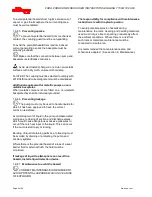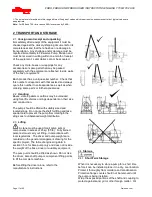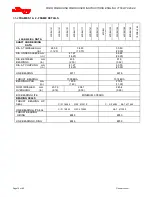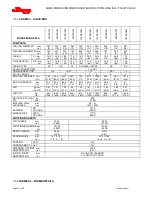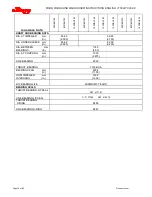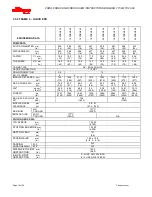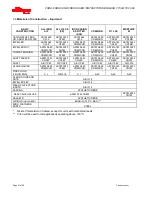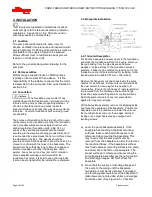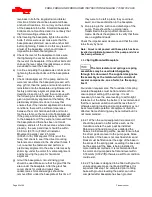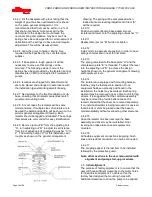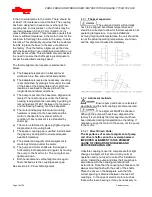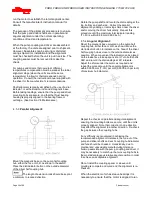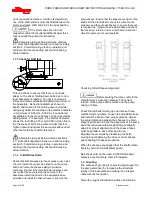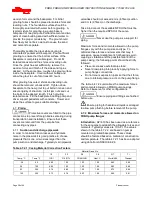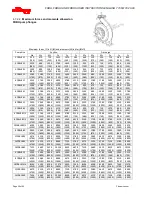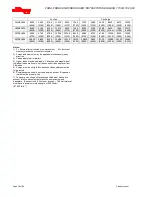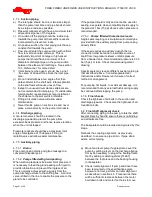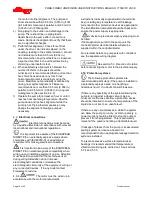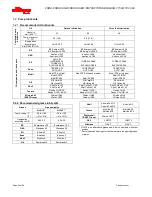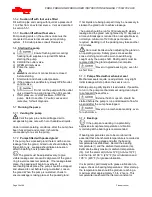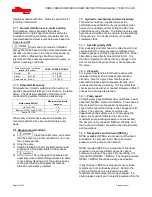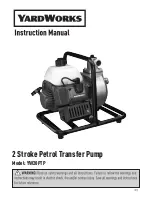
FRBH, FRBHX AND FRBHS USER INSTRUCTIONS ENGLISH 71569178 20-08
Page 22 of 60
Flowserve.com
®
4 INSTALLATION
Equipment operated in hazardous locations
must comply with the relevant explosion protection
regulations. See section 1.6.4,
Products used in
potentially explosive atmospheres.
4.1 Location
The pump should be located to allow room for
access, ventilation, maintenance and inspection with
ample headroom for lifting and should be as close as
practicable to the supply of liquid to be pumped.
Allow sufficient room to facilitate the back pull
-
out
feature on V
-
belt driven units.
Refer to the general arrangement drawing for the
pump set.
4.2 Part assemblies
Motors may be supplied loose on FRBH pumps,
typically on frame sizes 400 and above. It is the
responsibility of the installer to ensure that the motor
is assembled to the pump and lined up as detailed in
section 4.5.2.
4.3 Foundation
The foundation may consist of any
material that will afford permanent, rigid support to the
full area of the pump or driver supporting member. It
should be of sufficient size and mass to absorb
expected strains and shocks that may be encountered
in service. Concrete foundations built on solid ground
are desirable.
The purpose of foundation bolts is to anchor the pump
unit securely to the foundation such that the foundation
and pump assembly become a single structural unit.
High strength steel foundation bolts (SAE Gr. 5 or
equal) of the specified diameter should be located
according to the elevation drawing provided. Each bolt
is surrounded by a pipe sleeve that is two or three times
the diameter of the bolt. The sleeves should be
securely anchored and designed to allow the bolts to be
moved to conform with the holes in the baseplate. The
bolts should be sufficiently long to allow for wedges or
shims or levelling nuts under the baseplate, and a
washer, heavy hex nut and hex jam nut for retention.
Since baseplate levelling is performed after the
foundation has cured, it is best to use extra long bolts
that can be shortened after the installation is complete.
4.4 Baseplate installation
4.4.1 Grouted baseplates
Position the baseplate and pump next to the foundation
and clean the foundation surface thoroughly. Remove
the rag packing from the pipe sleeves and place
wedges or ships as close to the foundation bolts as
possible. These may be omitted if a jacking nut on the
foundation anchor bolts is preferred for levelling. Initial
levelling should be within 0.75 mm (.030 inches).
Remove the flange covers and check inside the pump
nozzles for cleanliness. Kerosene is recommended as
the best solvent for removing factory applied rust
preventative. Ensure that all traces of rust preventative
are removed from the discharge and suction flange
faces, the exposed shafting and all coupling surfaces.
Flush the pump internals of any rust preventative
applied for long-term storage.
Lift the baseplate assembly, remove the shipping skids
and clean the underside of the baseplate. Position the
baseplate over the foundation and lower the unit over
the foundation bolts and onto the wedges, shims or
jacking nuts. Larger basis may be equipped with
levelling screws.
a) Level the pump baseplate assembly. If the
baseplate has machined coplanar mounting
surfaces, these machined surfaces are to be
referenced when leveling the baseplate. This
may require that the pump and motor be
removed from the baseplate in order to reference
the machined faces. If the baseplate is without
machined coplanar mounting surfaces, the pump
and motor are to be left on the baseplate. The
proper surfaces to reference when leveling the
pump baseplate assembly are the pump suction
and discharge flanges. DO NOT stress the
baseplate.
b) Do not bolt the suction or discharge flanges of
the pump to the piping until the baseplate
foundation is completely installed. If equipped,
use leveling jackscrews to level the baseplate. If
jackscrews are not provided, shims and wedges
should be used. (See Figure 4-5.) Check for

